May 28, 2023 – Volume 25, Issue 6
In This Issue
- Flanigan’s Net Positive: Guo Jie Tai Chi
- Global Renewable Tipping Point
- University of California’s Flagship Climate Action
- Beaming Power from Space
- India Pauses New Coal
- Nitrogen and Digital-Data Footprints
- Terminator’s Climate Change Semantics
- Residential Solarports
- Flanigan’s Ego-Logic Podcast Updates
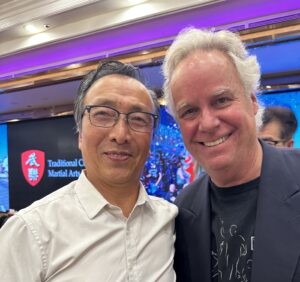
Flanigan’s Net Positive: Guo Jie Tai Chi
Pictured here I am with our Tai Chi master, Guo Jie, founder and leader of the Guo Jie Tai Chi Academy in Los Angeles. This past weekend, we toasted his skills and passion as he received the 2023 Lifetime Achievement Award from the Traditional Chinese Martial Arts Federation.
Guo Jie’s career, his life, is Tai Chi… first competing and later teaching. We are his students and continue to grow from his teaching, power and humility, and lust for life. He has imprinted our lives with discipline, his martial art.
Tai Chi is short for Tai chi chuan, an internal martial art practiced for its health benefits and defense training. There are five styles – Chen (which we practice), Yang, We Hao, Wu, and Sun – all of which trace their historical origins to Chen Village in China.
Tai Chi’s philosophy is rooted in Daoist and Confucian thought. Tai Chi incorporates the Daoist ideals of softness overcoming hardness, the flow between yin and yang. We learn to rest our tongues on the roofs of our mouths.
Our teacher/master – our “Sifu” – worked us hard. Our school in Monterey Park closed during the pandemic and sadly has not since opened. There we trained with vigorous calisthenics, too many squats, push-hand drills, rigorous kicks and striking techniques.
Full on sweat, then the forms. It took me a year of weekly instruction to learn the common form 24; three years to feel confident with 48. Later we learned 8 and 42. Advanced students use swords and spears.
Sifu scoffs at Tai Chi in the park. Frankly, that senior activity has a nice future appeal to me. But to Sifu, it’s painful to witness that form of Tai Chi, one that loosely abandons discipline. Like any art… Tai Chi’s fullest benefits are unlocked through its practice and honor of ancient forms.
“Straighten your spine. Drop the shoulders” (And while you’re at it, drop life’s tensions!) We learn abdominal breathing. Each routine begins by lowering the plane of our shoulders… by bending the knees and then keeping that level throughout the sequence. Burning thighs! Eyes follow the upper hand.
Some call it “shadowboxing.” For me, it’s moving yoga. I love the “cloud hands” and the synchronicity of hands in a set of motions, complemented by your legs in another set of motion. I love the “cat walk,” oh-so cautiously creeping backwards while keeping the force out front… with strong, spaced steps backward, pushing away energy all the while. No sound, no sighs, no grunts. Sifu would still find my form to be of considerable amusement!
Tai Chi is primarily an internal practice with internal rewards. For Terry and I, Tai Chi is a practice of the mind and body that we can do together. So thanks to Guo Jie as we celebrate his career and what he has done for us and others. His impact and contributions are larger than life, as he teaches so many to find a new sense of self through this silent and magical martial art.

Quote of the Month
“Every year we see carbon dioxide levels in our atmosphere increase as a direct result of human activity…. Every year, we see the impacts of climate change in the heat waves, droughts, flooding, wildfires, and storms happening all around us…. We must expend every effort to slash carbon pollution and safeguard this planet and the life that calls it home.”
Global Renewable Tipping Point
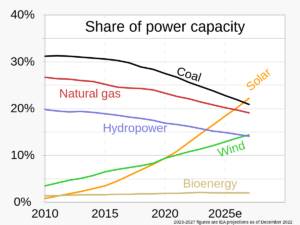
Good, tipping-point news. Clean energy investments globally, are outpacing investments in fossil fuels. This has been the case since 2020 according to the International Energy Agency’s World Energy Investment Report. In 2023, for every dollar spent on fossil fuels, clean energy received $1.70 in funding. Five years ago, the ratio was 1:1. Similarly, there’s more investment in solar than oil.
Factors driving this transition include the rise and deployment of battery technologies, as well as new demand for clean energy for electric vehicles and heat pumps. Then there’s war in the Ukraine and its resulting scramble for alternatives to oil and natural gas. Policies such as the Inflation Reduction Act and similar initiatives in Europe and Japan and elsewhere are driving change. The IRA rewards solar projects with domestic content with a 10% adder, on top of the 30% investment tax credit. IRA also provides special incentives for underserved communities, and for domestic solar manufacturing.

In 2023 these factors resulted in a global investment in solar power of $1 billion each day. Wood Mackenzie projects that the U.S. solar market will triple in the next five years. The industry had the best first quarter ever – 6.1 GW of solar – as supply chain issues and challenges have “faded” post pandemic, and as the IRA has helped surge demand for solar. The solar market is expected to grow to 378 GW by 2028. This is not only commercial and utility-scale applications, the residential market grew by 30% in the first quarter over last year to 1.6 GW of residential solar added. That is expected to rise to 36 GW over five years, a 6% annual growth rate. These are phenomenal numbers.
Over the tipping point in the transition from fossil fuels to clean energy resources… and we’d better be. The National Oceanic and Atmospheric Association, which records CO2 levels in the atmosphere at the Mauna Loa Atmospheric Baseline Observatory in Hawaii, reported a reading of 424 parts per million CO2 this past month, up from 421 ppm (0.7%) in May 2022. Note that CO2 levels in the Northern Hemisphere spike in May before the summer growing season in which flora takes in CO2 and reduces the atmospheric concentration.
This year’s rise in CO2 is the fourth largest rise ever, according to NOAA scientists and researchers at the University of California San Diego Scripps Institution of Oceanography. It’s certainly an unwanted increase while scientists and policy makers seek a plateau and then a decrease in emissions and CO2 levels. The current level, the all-time high of 424 PPM, is 50% higher than pre-industrial times and the highest level in three million years.
United Nations (IPCC) scientists warned in March that “the world is on thin ice,” grossly challenged to meet the 2015 Paris Agreement goals to limit CO2 to adhere to a maximum warming of 1.5 degrees Celsius. The scientists warned in October that the Earth will likely see an increase of 10% in CO2 levels over 2010 levels by 2030. Despite world leaders promising to tackle climate change… we’re experiencing the highest CO2 level in a million years.
Without question, there is much, much more to be done to protect Mother Earth, and fast. The good news is that the solutions abound. We have the technologies to turn the ship. Stanford Professor Mark Jacobson (a Flanigan’s Eco-Logic Podcast guest), is clear on solutions. His Solutions Project has mapped out means for 117 countries to be 100% carbon free in energy use. The big ticket items are offshore wind as well as solar power. The most important issues: scale and speed!
University of California’s Flagship Climate Action

The University of California has signed a contract to purchase 85 MW of renewable energy. The amount of power purchased is equivalent to the total power consumption of four colleges combined: U.C. Santa Cruz, U.C. Santa Barbara, U.C. Riverside, and U.C. Merced.
The green power will come from a massive, privately developed wind farm in New Mexico called SunZia Wind. Its developers, Patton Energy, are building a 550-mile transmission line to bring SunZia Wind’s power to market. The 3,500 MW utility-scale wind farm is slated to start construction this year with delivery of power slated for 2026.
Eight years ago, University of California signed its first solar contract. The recent purchase marks University of California’s first wind energy contract. It is also its largest renewable energy commitment in support of campus decarbonization. Energy from SunZia Wind will be used by every campus and medical center thanks to the U.C. Clean Power Program that operates through California’s Direct Access program. Direct access allows certain large users to source their own power, in this instance wind, and transmit it using others’ transmission and distribution lines.
University of California is ranked #1 by the U.S. EPA in terms of green electricity use among colleges and universities. UC has over 50 MW of on-campus projects, two utility-scale solar projects (Five Points: 60 MW and Giffen Solar Park: 20 MW), plus 45 MW coming online in 2025.
SunZia Wind is the largest wind project in Western Hemisphere and in U.S. history, a total investment of more than $8 billion. It has involved the cooperation of 10 federal agencies, five state agencies, and nine local authorities. The development underscored the lack of transmission for wind farms, and thus this added cost. SunZia built major transmission and had to route the line to accommodate the White Sands Missile Base. When power finally flows, it will be the culmination of a 17-year development process, a timeframe that many consider unsustainable as renewables must be scaled up quickly.
Beaming Power from Space

Image Courtesy SSPP
The Caltech Solar Space Program began in 2011 when Caltech received a $100+ million donation from philanthropist Donald Bren. The donation was intended to take space solar from concept to reality. From 2014 – 2017 Northrop Grumman provided a $12.5 million donation to the program. Donald Bren is quoted saying that, “the hard work and dedication of brilliant scientists at Caltech have advanced our dream of providing the world with abundant, reliable, and affordable power for the benefit of humankind.”
Space solar holds the promise of tapping unlimited and unimpeded solar power in space. Space solar has eight times as much punch as terrestrial solar, with panels placed anywhere on Earth. But not so fast! Space solar has been studied for years. First you need to get lightweight arrays into orbit, and then successfully unfurled. Second, you need some way to beam the power down to Earth. No small order!
On January 6th, Caltech launched its space solar prototype into orbit. It was payload aboard SpaceX’s Transporter-6 mission. Caltech’s project is called MAPLE – the Microwave Array for Power Transfer, Low-Orbit Experiment. Caltech scientists developed lightweight arrays that fold into a cube one meter per side, then unfurl and create an array measuring 150-feet per side. MAPLE is designed to beam power to Earth using lightweight microwave transmitters. This happened on May 22 when researchers were able to detect transmitted energy using a receiver on the roof of Caltech’s Gordon and Betty Moore Laboratory of Engineering…. the first time in history that energy was successfully sent to Earth from orbit.
Imagine its potential. Space solar systems can use arrays of transmitters to beam the energy to multiple receivers on Earth. This is also where major concerns arise… the notion of frying anything in the way of space solar being beamed to Earth. On the other hand, this new form of transmission may unlock means for serving power to remote areas out of reach of transmission grids. Proponents say that this form of wireless transmission has the potential to democratize energy access.
“In the same way that the Internet democratized access to information, we hope that wireless energy transfer democratizes access to energy…. no new transmission will be needed…. we can send energy to remote regions and areas devastated by war or natural disaster,” noted Caltech Co-Project Director Ali Hajimiri.
India Pauses New Coal
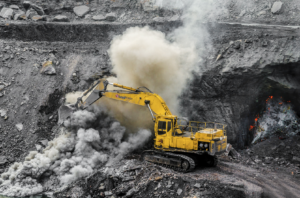
India is the third most populous country in the world. It is made up of 1.4 billion Indians. It has long been considered a great global threat to climate change due to its population growth and growth in use of highly-polluting coal-burning power plants. It has now put a pause on coal-fired power plants. For the next five years, the Indian government will not consider new applications for coal plants. This has been hailed as a major step by the global environmental community.
India is the world’s fifth latest economy and the third largest CO2 emitter. It has a goal of carbon neutrality by 2070. Its pause on new coal plants is good, but its stats are not. Reuters reports that as a result of intense heat waves, a colder than usual winter, that there was a jump in electricity demand. It grew by 11.5% in the fiscal year ending March 2023. That’s the sharpest increase since 1990. The 12.4% surge in coal use was in reaction to a 28.7% decline in gas use as global pricing deterred usage. Renewables have been growing at 11% annually thanks largely to solar which had a 35% increase in output.
At FY 2023 year-end, and according to Grid India data, India’s coal-fired power plants were generating 73.1% of the nation’s power. Increased fossil use has caused India’s CO2 emissions to rise by nearly a sixth to 1.15 billion tonnes. This while India, like all other parts of the world, is experiencing climate change with longer summers and hotter weather. As a result there has been a policy shift: Instead of 8,000 MW of new coal, India now plans 8,600 MW of battery energy storage.
The Central Electric Authority is responsible for the country’s electric power planning. It produces a plan every five years. To achieve a 500 GW goal for renewables by 2030, India will need to build 40 – 45 GW of renewables each year. Its current level of production is 17 GW of installations per year. India fell short of its milestone for 175 GW.
Nitrogen and Digital-Data Footprints

EcoMotion has recently completed a Greenhouse Gas inventory for San Diego Community College District. In addition to tracking the District’s carbon footprint, we presented the District with a measure of its nitrogen footprint, a measure of the amount of reactive nitrogen released to the environment from a campus’ resource consumption.
Let’s back up. Nitrogen (N2) makes up 80% of the atmosphere. It’s “reactive nitrogen” that’s problematic. Examples of reactive nitrogen include water pollutants such as nitrate (NO3) and ammonium (NH4); air quality pollutants including ammonia (NH3) and nitrogen oxides (NOx); and the greenhouse gas nitrous oxide (N2O).
When released to the environment, reactive nitrogen contributes to a cascade of negative impacts to human and ecosystem health including smog, acid rain, forest dieback, and eutrophication. Major sources of reactive nitrogen include food production (fertilizer runoff, manure management, food waste) and fossil-fuel combustion.
The nitrogen footprint calculator was originally developed at the University of Virginia in 2009 to calculate its own nitrogen footprint. With the support of the Environmental Protection Agency, the Nitrogen Footprint Tool was expanded for use by other campuses. It was then launched for pilot testing in 2014 and adopted thereafter. Tracking the carbon and nitrogen footprints together makes sense. Most reductions in the campus carbon footprint concurrently result in a reduction of the nitrogen footprint. To calculate a personal nitrogen footprint, see www.n-print.org.
The Digital Data Footprint: Every day, the average person creates 10 DVDs worth of data on their phone, fitness trackers, and emails. Put another way, each person creates 1.7 mb of data a second. By 2025, global data may be more than 180 zettabytes, 6.8 billion years of Netflix streaming. The amount of data is doubling every two years. Data centers are responsible for 3.5 – 3.7% of all human-induced carbon dioxide. That’s more than the aviation industry at 2.1%. Left unheeded, experts state that the data industry may account for more carbon emissions than the automotive, aviation, and energy sectors combined. Crazy it is. Known as “dark data,” 65% of it is never used and 15% is immediately out of date.
Researchers from Loughborough University in the United Kingdom have created the first measurement tool for calculating emissions caused by stored digital data. It’s called the Data Carbon Ladder. It helps to determine the appropriate size of datasets required, the optimal frequency for updates, and the most suitable storage location. The Data Carbon Ladder helps companies improve their data projects’ sustainability.
Terminator’s Climate Change Semantics
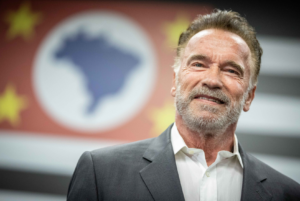
Governor Arnold Schwarzenegger – Mr. “I’ll Be Back” – is taking on the semantics of climate change. The former bodybuilder, real estate mogul, and politician believes that no-one “gives a s…” about climate change. The term, he believes, is too soft. Most are not alarmed, they need something more personal and direct to reach them. “Call it pollution,” says Arnold.
Schwarzenegger is one of a handful of Republicans that has been a champion of climate action. For many years, and throughout his gubernatorial tenure in California, he has been serious about reversing climate warming and disruptive climate change. He calls this existential issue a “humongous challenge.”
So how to get the people to take note and action? In an interview with CBS News, he noted that climate changes sounds subtle, warm, and even welcoming. Pollution, on the other hand, comes with a directly and fully negative connotation. Pollution, he says, still scares people.. We know it means early death, cancer, asthma, heart disease and more.
Schwarzenegger believes that a focus on pollution will stir up more action than climate change: “So my thing is, let’s go and rephrase this and communicate differently about it and really tell people we’re talking about pollution. Pollution creates climate change, and pollution kills.” “I’m on a mission to go and reduce greenhouse gasses worldwide, because I’m into having a healthy body and a healthy Earth.”
Residential Solarports

Image Courtesy of Solar Carports Direct
EcoMotion is pleased to welcome Benjamin Gold to our solar team. One of his first tasks was to respond to a query that EcoMotion fielded regarding manufacturers of residential carports for solar, or what we call “solar-ports.” While these are common in parking lots of schools and malls and the like, our team had seen very few examples of residential solar-ports. Ben did a great job of tracking down a rich variety of designs to cover cars and to provide shade for patios and the like. Click here to download his pictorial research review.
Flanigan’s Ego-Logic Podcast Updates
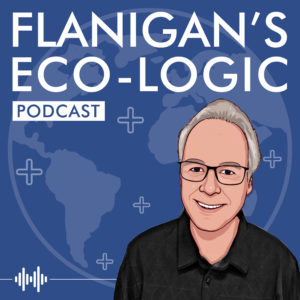
Use the links below to check out our recent podcasts. And you can always go to Spotify and type in “Ted Flanigan” to find our library of podcasts.
Recently Released:
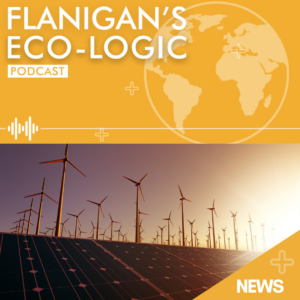
EcoNet News, Volume 25, Issue #6, highlights the impacts and achievements of Tai Chi master, Guo Jie, founder and leader of the Guo Jie Tai Chi Academy in Los Angeles as he received the 2023 Lifetime Achievement Award from the Traditional Chinese Martial Arts Federation. Ted shares good, tipping-point news; clean energy investments globally, are outpacing investments in fossil fuels. The issue also highlights the University of California’s flagship climate action, space solar, India’s pause on new coal, nitrogen and digital-data footprints, and Arnold Schwarzenegger’s climate change semantics.

In this episode of Flanigan’s Eco-Logic, Ted speaks with Greg Poschman, Pitkin County Commissioner for District 3. Greg has served on the boards or advisory boards of local non-profits, including Aspen Center for Environmental Studies (ACES), and on Pitkin County’s Healthy Rivers and Streams Advisory Board, from its founding until the fall before he ran for Commissioner in 2016. He’s also served on the Aspen Public Radio Advisory Board.
Greg knows the community well, having made many biographies and documentaries for and about local non-profits, including The Aspen Institute, Music Festival, Challenge Aspen, and the Aspen Hall of Fame. He’s travelled the world shooting documentaries and nature films, and over the course of his career, won 3 National Television Emmy awards for Directing and Camerawork.
In this podcast, he shares with Ted his motivation for joining the Board of County Commissioners, his most urgent issues to maintain the valley he calls home, his feelings of optimism around the role, and his intentions to serve another term.

In this episode of Flanigan’s Eco-Logic, father-daughter duo, Ted and Sierra Flanigan host the clean energy crash course on climate action. They start by discussing the wild fires on the East Coast, leading into a discussion on the climate crisis and how to be a part of the solution.
They break down climate action into three three broad parts: the electricity, mobility, and manufacturing sectors. Ted highlights developments in offshore wind, EVs, and buildings and industry.
In addressing the push for practical solutions, Ted and Sierra unpack materialism and quality of life. Part of the solution is making individual lifestyle changes and intentional decisions that serve oneself, community, and the planet at large.
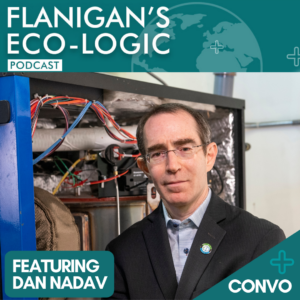
In this episode of Flanigan’s Eco-Logic, Ted speaks with Dan Nadav, Chief Executive Officer at Enviro Power. Dan has 20 years of experience in developing and deploying distributed generation technologies in North America and Europe. He is an expert in the commercialization of advanced energy technologies, and has led multiple product launch campaigns of various renewable technologies including geothermal, wind, waste heat recovery, and combined heat & power.
In his current role as Chief Executive Officer at Enviro Power, an advanced climate technology company that is revolutionizing the multi-billion heating system replacement market, Dan and his team are allowing property owners to generate on-site electricity within their existing heating system infrastructures. Enviro Power’s patented SmartWatt Boiler technology integrates a simple, low-pressure steam turbine into a condensing boiler structure. The product helps reduce carbon emissions at the same purchase, installation, and maintenance costs as replacing a traditional boiler. Dan shares that the SmartWatt Boiler is also positioned to become hydrogen-ready for future production of CO2-free heat and power.
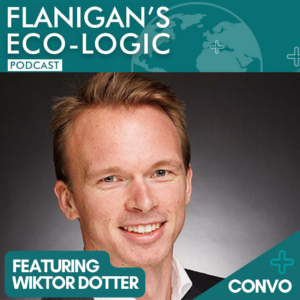
In this episode of Flanigan’s Eco-Logic, Ted speaks with Wiktor Dotter, Chief Executive Officer at ZeBeyond, a Swedish company that works with automotive sector manufacturers to find means to optimize their manufacturing efficiency. For instance, ZeBeyond helps manufacturers optimize sustainability and profitability, in light of rapidly changing market variables.
Based in Sweden, but of German descent, Wiktor has a corporate development background in original equipment manufacturers and Tier 1 and 2 businesses. He describes that the ever-changing amount of input parameters – sourcing of materials, their costs, labor costs, regulations, etc. — led Wiktor to develop ZeBeyond’s ePOP technology.
ePOP is a tool that enables designers to model changes of assumptions, for example when inputting EV battery pricing, and to optimize on green sources and profitability. At ZeByeond, Wiktor and his team are providing manufacturers with an innovative, reliable, and cost-effective decision-making tools for their products, ensuring reductions in R&D time while supporting their sustainability commitments.

In this episode of Flanigan’s Eco-Logic, Ted speaks with Rod Matthews, Co-founder and Chief Executive Officer at Brevian Energy, a renewable energy technology company based in California.
Rod is an experienced business technology consultant and microgrid solution provider with a background in aligning energy and technology initiatives with core business objectives. He formed Brevian to do his part in slowing down the impacts of climate change and believes the deployment of microgrids is a part of the solution.
At Brevian Energy, he’s on a mission to take what he’s learned as a business technology consultant and microgrid solution provider to educate real estate developers and property owners who are considering how and when to add microgrids, or other renewable energy infrastructure to their projects.
